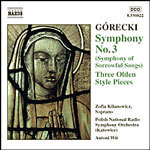
Symphony No. 3 (Symphony of Sorrowful Songs) / Three Olden Style Pieces
 $25.00
Out of Stock
$25.00
Out of Stock6+ weeks add to cart
GORECKI
Symphony No. 3 (Symphony of Sorrowful Songs) / Three Olden Style Pieces
Zofia Kilanowicz (soprano) / Polish National Radio Symphony Orchestra. Antoni Wit, conductor
[ Naxos / CD ]
Release Date: Monday 26 July 2004
This item is currently out of stock. It may take 6 or more weeks to obtain from when you place your order as this is a specialist product.
"as though his Polish forces had special insights denied to foreigners"
- CD Review
"this disc seems a clear first choice"
- Classic CD
"All in all, this seems in many ways a 'best buy'"
- Penguin Guide
"This recording is virtually as good as the betterknown Zinman version. The performance is exceptionally fine, although the acoustic is more resonant, the orchestral choirs less closely balanced and Antoni Wit isn't as meticulous as Zinman in his observance of minor details.
Interpretatively, Wit leaves the more austere impression. His relative inwardness squares convincingly with the symphony's harrowing texts and 'Sorrowful Songs' sub-title. If spectacular singing is your main priority, then Upshaw's is the vocal tour de force. Zofia Kilanowicz displays stronger lower registers and a brilliant, bleached-white soprano that reflects the score's innate pathos, its sense of shock. Her enunciation is more idiomatic, while her partial suspension of vibrato is a powerful interpretative ploy. What's most impressive about this performance is its spirituality; and given the overall excellence of the recording, the conducting and the singing, it's strongly recommended, particularly to those who have yet to discover the Symphony's hypnotic sound-world. It's also commended to those who do know the work but who find Upshaw and Zinman too 'plush'." (Gramophone)
The Polish composer Henryk Górecki was born in Silesia in 1933 and studied at the Katowice Conservatory and in Paris with Olivier Messiaen. He has made his subsequent career largely in Katowice, where he was appointed as a member of the Conservatory teaching staff. He has won a number of important awards for composition both at home and abroad, but earlier successes have been eclipsed by the phenomenal popularity of his Third Symphony, which has had a much wider appeal than could have been forecast, in part because of the relatively approachable musical language in which it is couched and in part because of its peculiar relevance to the mood of today, its anxieties, sorrows and hopes.
Górecki's musical idiom has developed gradually into a language of great originality. In earlier years influenced by serialism, in common with many other composers, he later shows the more overt influence of Messiaen and above all a preoccupation with instrumental sonorities. His interest in earlier music, in devotional texts and music often of Medieval origin, coupled with a fascination with the resources of the modern orchestra is often evident.
The Third Symphony was written in Katowice between October and December 1976 and dedicated to Górecki's wife. It was first performed at the avant-garde Festival of Royan the following year. The first movement opens with a canon for strings, building gradually through the possible orchestral register, starting with the double basses and mounting in pitch and intensity, as each part enters in imitation. At the heart of the movement is the 15th century Polish Lamentation of the Holy Cross Monastery, in which the Mother of Christ begs her dying Son to speak to her. After this the canon resumes, descending, as before it had risen, in both pitch and intensity, slowly unwinding to end with the single melodic line, the cantus firmus with which the movement had begun.
Tracks:
Symphony No.3, Op. 36 (Symphony of Sorrowful Songs)
Three Pieces in Olden Style